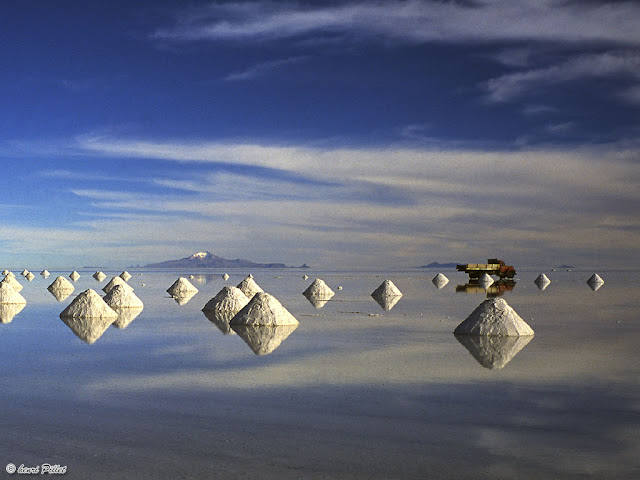Iguazu Falls, Iguassu Falls or Iguaçu Falls are waterfalls of the Iguazu River on the border of Brazilian State Paraná and Argentine Province Misiones. The falls divide the river into the upper and lower Iguazu. The Iguazu River originates near the city of Curitiba. It flows through Brazil for most of its course. Below its confluence with the San Antonio River, the Iguazu River forms the boundary between Argentina and Brazil. The name "Iguazu" comes from the Guarani or Tupi words "y" [ɨ], meaning "water", and "ûasú "[waˈsu], meaning "big". Legend has it that a god planned to marry a beautiful woman named Naipí, who fled with her mortal lover Tarobá in a canoe. In rage, the god sliced the river, creating the waterfalls and condemning the lovers to an eternal fall. The first European to find the falls was the Spanish conquistador Álvar Núñez Cabeza de Vaca in 1541.
No1 Amazing Things
Sunday, September 23, 2012
Fiji islands, Oceania
 The majority of Fiji's islands were formed through volcanic activity started around 150 million years ago. Today, some geothermal activity still occurs on the islands of Vanua Levu and Taveuni. Fiji has been inhabited since the second millennium BC. The country comprises an archipelago of more than 332 islands, of which 110 are permanently inhabited, and more than 500 islets, amounting to a total land area of circa 18,300 square kilometres (7,100 sq mi). The two major islands, Viti Levu and Vanua Levu, account for 87% of the population of almost 850,000. The former contains Suva, the capital and largest city. Most of Fijians live on Viti Levu's coasts, either in Suva or in smaller urban centres. Viti Levu's interior is sparsely inhabited due to its terrain.
The majority of Fiji's islands were formed through volcanic activity started around 150 million years ago. Today, some geothermal activity still occurs on the islands of Vanua Levu and Taveuni. Fiji has been inhabited since the second millennium BC. The country comprises an archipelago of more than 332 islands, of which 110 are permanently inhabited, and more than 500 islets, amounting to a total land area of circa 18,300 square kilometres (7,100 sq mi). The two major islands, Viti Levu and Vanua Levu, account for 87% of the population of almost 850,000. The former contains Suva, the capital and largest city. Most of Fijians live on Viti Levu's coasts, either in Suva or in smaller urban centres. Viti Levu's interior is sparsely inhabited due to its terrain.In the 17th and 18th centuries, the Dutch and the British explored Fiji. Fiji was a British colony up until 1970; British occupation lasted almost a century. During World War II, the United Kingdom allowed for many thousands of Fijians to volunteer to aid in Allies' efforts via their attachment to the New Zealand and Australian army units; the Republic of Fiji Military Forces (RFMF) consist of land and naval units.
Because of the abundance of forest, mineral, and fish resources, Fiji is one of the most developed economies in the Pacific island realm. Today, the main sources of foreign exchange are its tourist industry and sugar exports. The country's currency is the Fijian dollar.
 Fiji has a local government system where city and town councils fall under the general supervision of the Ministry of Local Government and Urban Development. President Ratu Epeli Nailatikau became Fiji's president, after a high court ruled that the military leadership was unlawfully appointed after a 2006 coup.
Fiji has a local government system where city and town councils fall under the general supervision of the Ministry of Local Government and Urban Development. President Ratu Epeli Nailatikau became Fiji's president, after a high court ruled that the military leadership was unlawfully appointed after a 2006 coup.The amazing Chameleon
 |
| Photo by Giovanni Mari |
Saturday, September 22, 2012
Tiger's Nest monastery, Bhutan
Paro Taktsang (spa phro stag tshang / spa gro stag tshang), is the popular name of Taktsang Palphug Monastery (also known as The Tiger's Nest), a prominent Himalayan Buddhist sacred site and temple complex, located in the cliffside of the upper Paro valley, Bhutan. A temple complex was first built in 1692, around the Taktsang Senge Samdup (stag tshang seng ge bsam grub) cave where Guru Padmasambhava is said to have meditated for three years, three months, three weeks, three days and three hours in the 8th century. Padmasambhava is credited with introducing Buddhism to Bhutan and is the tutelary deity of the country. Today, Paro Taktsang is the best known of the thirteen taktsang or "tiger lair" caves in which he meditated.
The Guru mTshan-brgyad Lhakhang, the temple devoted to Padmasambhava (also known as Gu-ru mTshan-brgyad Lhakhang, "The Temple of the Guru with Eight Names") is an elegant structure built around the cave in 1692 by Gyalse Tenzin Rabgye; and has become the cultural icon of Bhutan. A popular festival, known as the Tsechu, held in honour of Padmasambhava, is celebrated in the Paro valley sometime during March or April.
Salar de Uyuni, Bolivia
Seasonal floods transform the large, dry surfaces of the world's largest salt flat into one of the biggest mirrors on Earth. Salar de Uyuni, near the crest of the Andes, is made up of the remains of dried-up prehistoric lakes. The unusually flat and reflective salt crust gives visitors the illusion they are walking on clouds.
Although little wildlife or vegetation lives on the flats, it is a breeding ground for three species of pink flamingos. Visitors should have sun protection, warm clothing and plenty of water.
Although little wildlife or vegetation lives on the flats, it is a breeding ground for three species of pink flamingos. Visitors should have sun protection, warm clothing and plenty of water.
Subscribe to:
Comments (Atom)







